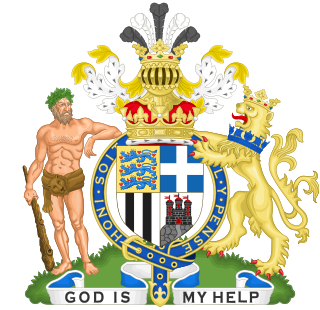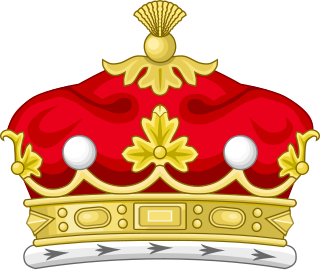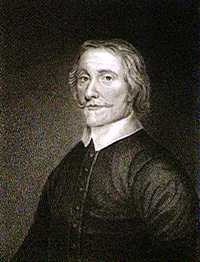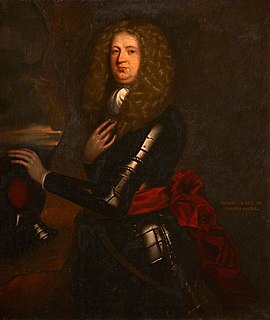Related Research Articles

Duke of Edinburgh, named after the city of Edinburgh in Scotland, was a substantive title that has been created three times since 1726 for members of the British royal family. It does not include any territorial landholdings and does not produce any revenue for the title holder.
The Peerage of Ireland consists of those titles of nobility created by the English monarchs in their capacity as Lord or King of Ireland, or later by monarchs of the United Kingdom of Great Britain and Ireland. It is one of the five divisions of Peerages in the United Kingdom. The creation of such titles came to an end in the 19th century. The ranks of the Irish peerage are duke, marquess, earl, viscount and baron. As of 2016, there were 135 titles in the Peerage of Ireland extant: two dukedoms, ten marquessates, 43 earldoms, 28 viscountcies, and 52 baronies. The Crown of the United Kingdom of Great Britain and Northern Ireland continues to exercise jurisdiction over the Peerage of Ireland, including those peers whose titles derive from places located in what is now the Republic of Ireland. Article 40.2 of the Constitution of Ireland forbids the state conferring titles of nobility and an Irish citizen may not accept titles of nobility or honour except with the prior approval of the Irish government. This issue has not arisen in respect of the Peerage of Ireland because no creation of titles in it has been made since the constitution came into force.

Marquess of Rockingham, in the County of Northampton, was a title in the Peerage of Great Britain. It was created in 1746 for Thomas Watson-Wentworth, 1st Earl of Malton. The Watson family descended from Lewis Watson, Member of Parliament for Lincoln. He was created a Baronet, of Rockingham Castle in the County of Northampton, in the Baronetage of England in 1621. In 1645 he was further honoured when he was raised to the Peerage of England as Baron Rockingham. The third Baron served as Lord-Lieutenant of Kent. In 1714 he was created Baron Throwley, Viscount Sondes and Earl of Rockingham in the Peerage of Great Britain. His eldest son Edward Watson, Viscount Sondes, predeceased him and he was succeeded by his grandson, the second Earl. The second Earl was Lord-Lieutenant of Kent before his early death in 1745. He was childless and was succeeded by his younger brother, Thomas. He had previously represented Canterbury in Parliament.

Marquess Conyngham, of the County of Donegal, is a title in the Peerage of Ireland. It was created in 1816 for Henry Conyngham, 1st Earl Conyngham. He was the great-nephew of another Henry Conyngham, 1st Earl Conyngham, a member of a family of Scottish descent which had settled during the Plantation of Ulster in County Donegal in Ireland in the early 17th century. The 'founder' of the dynasty in Ireland was The Very Rev. Dr. Alexander Cunningham, Dean of Raphoe. The earlier Henry was a member of both the Irish House of Commons and the British House of Commons and served as Vice-Admiral of Ulster and as Governor of the counties of Donegal and Londonderry. In 1753 he was raised to the Peerage of Ireland as Baron Conyngham, of Mount Charles in the County of Donegal, and in 1756 he was created Viscount Conyngham, in Ireland, also in the Peerage of Ireland. In 1781 he was made Baron Conyngham, of Mount Charles in the County of Donegal, with remainder to his nephew Francis Burton, and Earl Conyngham, of Mount Charles in the County of Donegal, which like the creations of 1753 and 1756 was created with normal remainder to the heirs male of his body. The latter titles were also in the Peerage of Ireland. Lord Conyngham was childless and on his death in 1781 the barony of 1753, the viscountcy and earldom became extinct while he was succeeded in the barony of 1781 according to the special remainder by his aforementioned nephew Francis. He was the eldest son of Mary, sister of the first Earl Conyngham, by her husband Francis Burton. The new 2nd Baron Conyngham, who had earlier represented Killybegs and County Clare in the Irish House of Commons, assumed by Royal licence the surname and arms of Conyngham on succeeding to the titles.

Earl of Halifax is a title that has been created four times in British history—once in the Peerage of England, twice in the Peerage of Great Britain, and once in the Peerage of the United Kingdom. The name of the peerage refers to Halifax, West Yorkshire.

Earl of Romney is a title that has been created twice.

Baron Carleton is a title that has been created three times in British history, once in the Peerage of Ireland and twice in the Peerage of Great Britain. The first creation came in the Peerage of England in 1626 when Sir Dudley Carleton was made Baron Carleton, of Imbercourt in the County of Surrey. He was made Viscount Dorchester two years later. See the article on him for more information on this creation. Dudley Carleton was the first cousin of Sir John Carleton, 1st Baronet.

Earl of Drogheda is a title in the Peerage of Ireland. It was created in 1661 for The 3rd Viscount Moore.

Viscount Valentia is a title in the Peerage of Ireland. It has been created twice. The first creation came in 1621 for Henry Power. A year later, his kinsman Sir Francis Annesley, 1st Baronet, was given a "reversionary grant" of the viscountcy, which stated that on Power's death Annesley would be created Viscount Valentia. Annesley, a member of an influential Anglo-Irish family which descended from Newport Pagnell in the County of Buckinghamshire, was a favourite of James I, who granted him land in Ireland, notably the fort of Mountnorris in County Armagh. He was knighted in 1616, created a baronet, of Newport Pagnell in the County of Buckingham, in the Baronetage of Ireland in 1620 and Baron Mountnorris, of Mountnorris in the County of Armagh, in 1628.

Baron Carrington is a title that has been created three times, once in the Peerage of England, once in the Peerage of Ireland and once in the Peerage of Great Britain.
Earl of Clare was a title of British nobility created three times: once each in the peerages of England, Great Britain and Ireland.
The titles of Baron Mountjoy and Viscount Mountjoy have been created several times for members of various families, including the Blounts and their descendants and the Stewarts of Ramelton and their descendants.

Viscount Clifden, of Gowran in the County of Kilkenny, Ireland, was a title in the Peerage of Ireland. It was created on 12 January 1781 for James Agar, 1st Baron Clifden. He had already been created Baron Clifden, of Gowran in the County of Kilkenny, in 1776, also in the Peerage of Ireland. The Viscounts also held the titles of Baron Mendip in the Peerage of Great Britain from 1802 to 1974 and Baron Dover from 1836 to 1899, when this title became extinct, and Baron Robartes from 1899 to 1974, when this title became extinct, the two latter titles which were in the Peerage of the United Kingdom. The interrelated histories of the peerages follows below.

Baron Sydney was a title that was created three times in British history. The title was later elevated twice into a viscounty, and from there, once more into an earldom.

Earl Fitzwilliam was a title in both the Peerage of Ireland and the Peerage of Great Britain held by the head of the Fitzwilliam family.

Viscount FitzWilliam, of Merrion in the County of Dublin, was a title in the Peerage of Ireland. It was created in 1629 for Thomas FitzWilliam, along with the subsidiary title Baron FitzWilliam, of Thorncastle in the County of Dublin, also in the Peerage of Ireland. He was succeeded by his son Oliver, the second Viscount. In 1661 Oliver was created Earl of Tyrconnell in the Peerage of Ireland. The earldom became extinct on his death in 1667, but he was succeeded in the barony and viscountcy by his younger brother William FitzWilliam, the third Viscount. William's grandson Richard, the fifth Viscount, represented Fowey in the British Parliament. His son Richard, the sixth Viscount, was a member of both the Irish and English Privy Councils. The seventh Viscount was a benefactor and musical antiquarian. The titles became extinct on the death of the ninth Viscount in 1833.

Earl of Dorchester, in the County of Dorset, was a title in the Peerage of Great Britain. It was created in 1792 for Joseph Damer, 1st Baron Milton. He was a politician but is best remembered for the reshaping of Milton Abbey and the creation of the village of Milton Abbas in Dorset. Damer had already been created Baron Milton, of Shronehill in the County of Tipperary, in the Peerage of Ireland, in 1753 and Baron Milton, of Milton Abbey in the County of Dorset, in the Peerage of Great Britain, in 1762. In 1792 he was made Viscount Milton, of Milton Abbey in the County of Dorset, at the same time he was given the earldom. He was succeeded by his elder son. The second earl was a politician and notably served as Chief Secretary for Ireland between 1794 and 1795. He was unmarried and the titles became extinct on his death in 1808.

Earl Ligonier was a title that was created twice in British history, once in the Peerage of Great Britain and once in the Peerage of Ireland. The first creation came in the Peerage of Great Britain on 10 September 1766 in favour of the French-born soldier Field Marshal John Ligonier. The peerage was created with normal remainder to the heirs male of his body. He had already been created Viscount Ligonier, of Enniskillen, in the Peerage of Ireland on 31 December 1757, with normal remainder to the heirs male of his body, and Viscount Ligonier, of Clonmell, in the Peerage of Ireland on 20 May 1762, with remainder to his nephew, Edward Ligonier. In 1763 he was also created Lord Ligonier, Baron of Ripley, in the County of Surrey, in the Peerage of Great Britain, with normal remainder to the heirs male of his body. The barony, viscountcy of 1757 and earldom became extinct on his death on 28 April 1770 while he was succeeded in the viscountcy of 1762 according to the special remainder by his nephew, the second Viscount. Edward Ligonier was the illegitimate son of Colonel Francis Augustus Ligonier, brother of the first Earl. On 19 July 1776 the earldom was revived when he was made Earl Ligonier, of Clonmell in the County of Tipperary, in the Peerage of Ireland. The titles became extinct on his death on 14 June 1782.

Baron Pierrepont is a title that has been created four times in British history. The first creation came in the Peerage of England on 29 June 1627 when Sir Robert Pierrepont was created Baron Pierrepont, also being created Viscount Newark at the same time. He was further created Earl of Kingston-upon-Hull in 1628. The fifth Earl was created Duke of Kingston-upon-Hull in 1715 in the Peerage of Great Britain, with the Dukedom becoming extinct on the death of the second Duke in 1773.

Earl of Clanbrassil was a title that was created twice in the Peerage of Ireland, both times for members of the Hamilton family. Clanbrassil was the name of an old Gaelic territory in what is now the barony of Oneilland East in the north-east of modern County Armagh, Northern Ireland.